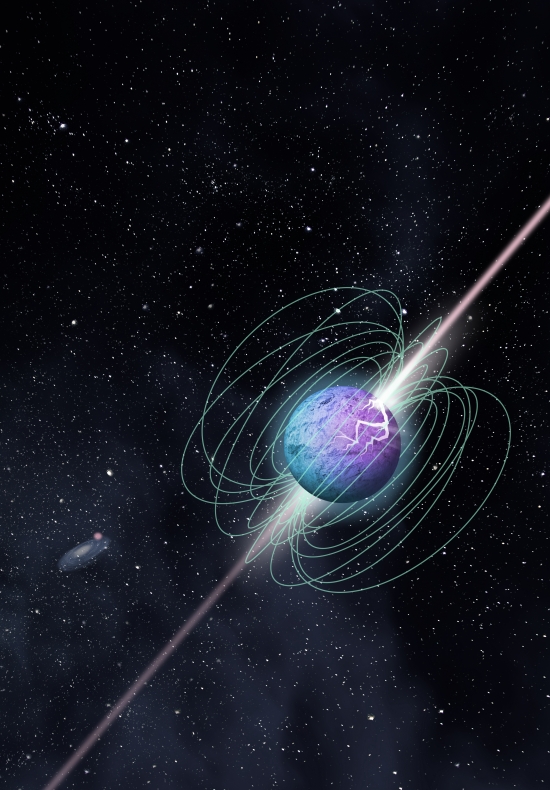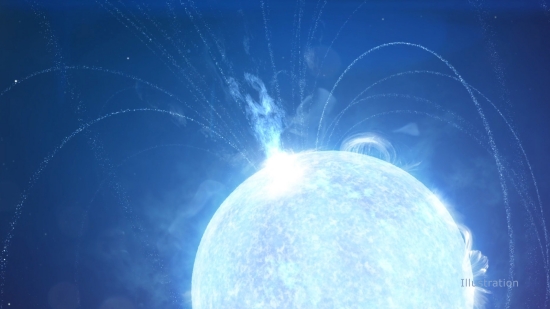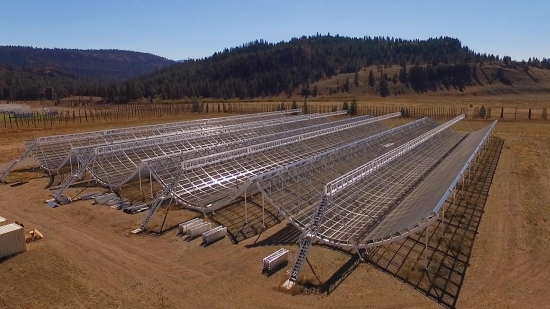A sequence of new observations gives us a leading candidate to explain Fast Radio Bursts (FRBs). These powerful bursts of radio waves, lasting but milliseconds, first turned up in our data in 2007 and have been a mystery ever since. As they were found in other galaxies, it has been difficult to determine their exact location, and they were impossible to predict as most seemed to be one-off events, although astronomers have subsequently found some that do repeat.
Among the possible causes of FRBs, stellar remnants have been put forward, with the kind of highly magnetic neutron stars called magnetars receiving close scrutiny because their magnetic fields could be the engine driving the bursts. We now have three papers in Nature that give us tight observational evidence of the kind that has been lacking. Between the three, we have data that for the first time link an FRB in our own galaxy to a magnetar, the object known as SGR 1935+2154, located in the constellation Vulpecula.

Image: Artist’s impression of a magnetar in outburst, showing complex magnetic field structure and beamed emission, here imagined as following a crust cracking episode. Credit: McGill University Graphic Design Team.
Let’s look at the events involved here. We begin with two space-based observatories. Both the Fermi Gamma-ray Space Telescope and the Neil Gehrels Swift Observatory registered rapid bursts of gamma- and X-rays from this object in late April. The spate of burst activity lasted for hours and was also observed by NASA’s Neutron star Interior Composition Explorer, an X-ray telescope mounted on the International Space Station.
This was followed by observations about thirteen hours later of another X-ray burst, once again seen by numerous instruments, including the European Space Agency’s INTEGRAL mission as well as China’s Huiyan X-ray satellite and the Russian Konus gamma-ray burst monitor, a Russian experiment that flies aboard NASA’s GGS-Wind spacecraft. This was a burst lasting about half a second, but as it flared, the Canadian Hydrogen Intensity Mapping Experiment (CHIME) and the Survey for Transient Astronomical Radio Emission 2 (STARE2), located at CalTech, detected a Fast Radio Burst (FRB 200428) in the same part of the sky.
Scientists at the Chinese Five-hundred-meter Aperture Spherical radio Telescope (FAST) had been observing SGR 1935+2154 for some weeks. As I understand it, they did not see FRB 200428, but were subsequently able to detect an FRB at the same location (FAST was not observing the object when FRB 200428 was detected by the other instruments).
Citations for papers from both the CHIME/FRB Collaboration and the STARE2 team are given below, along with a citation for a paper from FAST astronomers that provides limits to the radio flux of the FRB. The authors of the latter find a ‘weak correlation’ between FRBs and SGR 1935+2154, as co-author Zhang Bing (University of Nevada) explains:
“The weak correlation could be explained by special geometry and/or limited bandwidth of FRBs. The observations of SGR J1935 start to reveal the magnetar origin of FRBs, although other possibilities still exist.”
So we have a burst of X-rays associated with an FRB, the latter radio component detected first at CHIME and then STARE2. Moreover, the radio burst from SGR 1935+2154 was thousands of times brighter than any radio emissions previously observed from magnetars in the Milky Way, and in fact would have registered as a weak FRB had it occurred in another galaxy. The arrival of the radio pulse during an X-ray burst points to this magnetar as the source.
Paul Scholz is a researcher at the University of Toronto’s Dunlap Institute for Astronomy & Astrophysics and a member of the CHIME/FRB Collaboration:
“The radio burst was far brighter than anything we had seen before, so we immediately knew it was an exciting event. We’ve studied magnetars in our galaxy for decades, while FRBs are an extragalactic phenomenon whose origins have been a mystery. This event shows that the two phenomena are likely connected.”

Image: A powerful X-ray burst erupts from a magnetar – a super-magnetized version of a stellar remnant known as a neutron star – in this illustration. A radio burst detected April 28 occurred during a flare-up like this on a magnetar called SGR 1935. Credit: NASA’s Goddard Space Flight Center/Chris Smith (USRA).
The magnetic field of a magnetar can be a thousand times stronger than that of a typical neutron star, offering us a generous source of power, but at the same time, the radio burst from SGR 1935+2154 was thousands of times brighter than any radio emissions ever detected from magnetars in our galaxy. Paul Scholz has speculated that it may require the youngest, most active magnetars to explain the range of FRB sources we’ve thus far observed elsewhere, although we have yet to make a simultaneous detection tying an FRB with an X-ray burst in another galaxy, a signature that efforts like CHIME will continue to look for.
George Younes (George Washington University) is lead author on two upcoming papers on the FRB. Here he speculates on the nature of the burst activity:
“The bursts seen by NICER and Fermi during the storm are clearly different in their spectral characteristics from the one associated with the radio blast. We attribute this difference to the location of the X-ray flare on the star’s surface, with the FRB-associated burst likely occurring at or close to the magnetic pole. This may be key to understanding the origin of the exceptional radio signal.”

Image: This aerial view shows the Canadian Hydrogen Intensity Mapping Experiment (CHIME), a radio telescope located at Dominion Radio Astrophysical Observatory in British Columbia. Credit: Richard Shaw/UBC/CHIME Collaboration.
So we have the first FRB found in the Milky Way, one whose association with a magnetar may help us place these bursts in context now that we know magnetars can drive FRB activity. On exactly how a magnetar produces an FRB, I want to quote Amanda Weltman and Anthony Walters, who provide a fine overview of this work in an article in Nature that is not behind the journal’s firewall:
…there are several mechanisms by which magnetars can drive FRBs, each of which has a distinct observational signature. The new results thus open up a host of exciting problems to explore. For example, what theoretical mechanism could give rise to such bright, yet rare, radio bursts with X-ray counterparts? One promising possibility is that a flare from a magnetar collides with the surrounding medium and thereby generates a shock wave. Observations of nearby rapidly star-forming galaxies will be crucial for finding events similar to FRB 200428, to help pin down the actual mechanism.
The paper from the STARE team is Bochenek et al., “A fast radio burst associated with a Galactic magnetar,” Nature 587 (2020), pp. 59-62 (abstract). The CHIME/FRB paper is “A bright millisecond-duration radio burst from a Galactic magnetar,” Nature 587 (2020), pp. 54-58 (abstract). The Lin paper is “No pulsed radio emission during a bursting phase of a Galactic magnetar,” Nature 587 (2020), pp. 63-65 (abstract).



I feel somewhat proud that the first paper ever that proposed a direct connection between magnetars and FRBs was written by my astrophysics professors back in 2007, a fact acknowledged in the Nature publication: https://www.researchgate.net/publication/1769504_Hyperflares_of_SGRs_as_an_engine_for_millisecond_extragalactic_radio_bursts
Yet another example of an initially unexplained phenomenon that had the “alien messaging” believers contributing their theories, yet now apparently having a natural explanation.
ET communication should be considered an “extraordinary claim” and treated as such, rather than as a hypothesis on a par with natural ones.
I hope that if/when we get a message or visit (even a flyby), that the evidence is far less ambiguous, even unambiguous. A message preamble with repeating series of prime numbers. A ship that makes maneuvers in the solar system that cannot be accomplished by any natural forces. And so on.
As a test of the reverse, how many artificial phenomena that humans generate have potential natural explanations making the phenomenon ambiguous as to its artificial status?
I tried to craft a number of replies to this, and each time felt like I was stepping into philosophical quicksand (and maybe still am).
Do distinctions like “artificial” vs “natural” even make sense with respect to something sufficiently alien? If humans are products of nature, isn’t anything we do in a sense just nature once removed, and wouldn’t the same be true of anything aliens do? Not trying to be facetious, just have a sense that the question is much bigger than it first appears to be…
Perhaps the distinction between natural and artificial is using the wrong terms. Human technology is just a hypertrophied form of Dawkins’ “extended phenotype”. Straight edges on structures look artificial, but beavers make dams with fairly straight logs. However, only humans make huge dams with smooth edges that clearly look designed, rather than due to natural forces.
So by natural I mean outcomes that can be modeled on processes that end up with high entropy (in an information sense). Artificial processes tend to have much lower entropy as they are designed to reduce variability.
From a observational POV, em emissions with very narrow spectral bandwidth are more likely to be technology. Signal strength patterns of numbers like primes imply generation by agency. If you view the western US-Canada border from space, the straight line of the border due to cultivation on the US side is readily apparent and not likely due to any stochastic process.
Advanced civilizations may well also tend to look more like natural systems, for a variety of reasons. Organic architecture eshews straight edges and flat surfaces and is very aesthetically pleasing to my eye. Underground and bermed dwellings also look more naturalistic and come with ecological benefits. Manufactured goods may become far more recyclable and less waste producing. Light pollution may be much reduced, even eliminated.
I am glad you raised the issue because these are issues that I am raising in a future CD post.
The flare colliding with the surrounding media would cause the x rays if the material was heated to a high temperature by a Magnetar flare. Also some Magnetars are pulsars, so they emit x rays due to the acceleration of electrons which emit a large portion of the electro magnetic spectrum including radio waves. It makes sense that coinciding x rays and radio emissions or FRB could be from Magnetars.
If this hypothesis is correct, Suppose that described mechanism should cause also gravitational waves, so there is hope that some future LIGO / VIRGO upgrades will allow to detect gravitation footprints of such events.
They can typically emit 80 years of the sun’s output in milli seconds. Move over the Death Star, Thats huge !
https://earthsky.org/space/repeating-fast-radio-burst-frb-121102-wakes-up-chime
https://arxiv.org/abs/1701.01109
[Submitted on 2 Jan 2017 (v1), last revised 27 Feb 2017 (this version, v2)]
Fast Radio Bursts from Extragalactic Light Sails
Manasvi Lingam, Abraham Loeb
We examine the possibility that Fast Radio Bursts (FRBs) originate from the activity of extragalactic civilizations. Our analysis shows that beams used for powering large light sails could yield parameters that are consistent with FRBs.
The characteristic diameter of the beam emitter is estimated through a combination of energetic and engineering constraints, and both approaches intriguingly yield a similar result which is on the scale of a large rocky planet. Moreover, the optimal frequency for powering the light sail is shown to be similar to the detected FRB frequencies.
These `coincidences’ lend some credence to the possibility that FRBs might be artificial in origin. Other relevant quantities, such as the characteristic mass of the light sail, and the angular velocity of the beam, are also derived. By using the FRB occurrence rate, we infer upper bounds on the rate of FRBs from extragalactic civilizations in a typical galaxy.
The possibility of detecting fainter signals is briefly discussed, and the wait time for an exceptionally bright FRB event in the Milky Way is estimated.
Comments: 7 pages, Accepted for publication in The Astrophysical Journal Letters (ApJL)
Subjects: High Energy Astrophysical Phenomena (astro-ph.HE); Cosmology and Nongalactic Astrophysics (astro-ph.CO)
DOI: 10.3847/2041-8213/aa633e
Cite as: arXiv:1701.01109 [astro-ph.HE]
(or arXiv:1701.01109v2 [astro-ph.HE] for this version)
Submission history
From: Manasvi Lingam [view email]
[v1] Mon, 2 Jan 2017 19:16:52 UTC (67 KB)
[v2] Mon, 27 Feb 2017 06:09:39 UTC (67 KB)
https://arxiv.org/pdf/1701.01109.pdf
https://arxiv.org/abs/2006.08493
[Submitted on 15 Jun 2020 (v1), last revised 6 Nov 2020 (this version, v2)]
A Quantitative Assessment of Communicating Extra-Terrestrial Intelligent Civilizations in the Galaxy and the Case of FRB-like Signals
Bing Zhang (UNLV)
A formula is proposed to quantitatively estimate the signal emission rate of Communicating Extra-Terrestrial Intelligent civilizations (CETIs) in the Galaxy. I suggest that one possible type of CETI signal would be brief radio bursts similar to fast radio bursts (FRBs).
A dedicated search for FRB-like artificial signals in the Galaxy for decades may pose a meaningful upper limit on the emission rate of these signals by CETIs. The Fermi-Hart paradox is answered in terms of not having enough observing times for this and other types of signals.
Whether humans should send FRB-like signals in the far future is briefly discussed.
Comments: 9 pages, published version in Frontiers of Physics
Subjects: Popular Physics (physics.pop-ph); Earth and Planetary Astrophysics (astro-ph.EP); High Energy Astrophysical Phenomena (astro-ph.HE)
Journal reference: Frontiers of Physics, 15(5), 54501 (2020)
DOI: 10.1007/s11467-020-0973-5
Cite as: arXiv:2006.08493 [physics.pop-ph]
(or arXiv:2006.08493v2 [physics.pop-ph] for this version)
Submission history
From: Bing Zhang [view email]
[v1] Mon, 15 Jun 2020 15:51:01 UTC (60 KB)
[v2] Fri, 6 Nov 2020 20:01:19 UTC (60 KB)
https://arxiv.org/pdf/2006.08493.pdf
HST has found the source of five FRBs, but their true natures are still in question:
https://www.universetoday.com/151268/hubble-has-tracked-down-the-source-of-5-different-fast-radio-bursts/
Guess what – massive cosmic forces and explosions are not the obvious answers, at least in these cases.